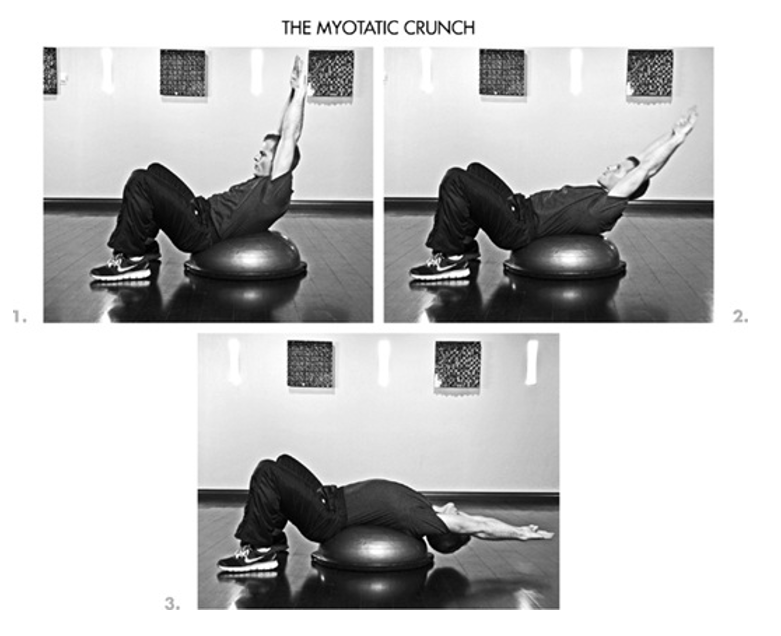From “The 4 Hour Body”:
In 2005, my interest in kettlebells reinvigorated, I returned to the United States from Argentina and purchased one 53-pound kettlebell. I did nothing more than one set of 75 swings one hour after a light, protein-rich breakfast, twice a week on Mondays and Fridays. In the beginning, I couldn’t complete 75 consecutive repetitions, so I did multiple sets with 60 seconds between until I totaled 75.
Total swing time for the entire week was 10–20 minutes. I wanted abs. In six weeks, I was at my lowest bodyfat percentage since 1999.

My weekly training schedule was so light as to be laughable by conventional standards. I also took 10–20-minute ice baths (two bags of ice bought at a gas station) on Mondays, Wednesdays, and Fridays.
DAY 1 (MONDAY)
• High-rep kettlebell (53 pounds) swings to at least 75 reps (ultimately, I got to 150+ reps in a single set)
• Slow myotatic crunch (abs) with max weight x 10–15 slow reps
DAY 2 (WEDNESDAY)
I alternated these two exercises for a total of 3 sets × 5 reps for each. I took two minutes between all sets and therefore had at least four minutes between the same exercise (e.g., dumbbell [DB] press, wait two minutes, row, wait two minutes, DB press, etc.):
• Iso-lateral dumbbell incline bench press
• “Yates” bent rows with EZ bar (palms-up grip and bent at the waist about 20–30 degrees)
DAY 3 (FRIDAY)
• High-rep kettlebell (53 pounds) swings to 75-rep minimum
• Slow myotatic crunch (abs) with max weight x 12–15 reps
• Every other week: single-arm kettlebell swings to 25 minimum reps each side
I should add that I was negligent, often adding one to three additional rest days between sessions. It didn’t matter. The training volume needed for head-turning changes was lower than even I thought possible. Though I added in a few extras for other reasons, the king of exercises — the two-arm kettlebell swing — is all you need for dramatic changes.
Here are a few guidelines:
• Stand with your feet 6–12 inches outside of shoulder width on either side, each foot pointed outward about 30 degrees. If toes pointed straight ahead were 12:00 on a clock face, your left foot would point at 10:00 or 11:00, and your right would point at 1:00 or 2:00.
• Keep your shoulders pulled back (retracted) and down to avoid rounding your back.
• The lowering movement (backswing) is a sitting-back-on-a-chair movement, not a squatting-down movement.
• Do not let your shoulders go in front of your knees at any point.
• Imagine pinching a penny between your butt cheeks when you pop your hips forward. This should be a forceful pop, and it should be impossible to contract your butt checks more. If your dog’s head gets in the way, it should be lights out for Fido.

The Myotatic Crunch
So named because it leverages the fully stretched position and the resultant reex (myotatic reflex or stretch reflex) for a stronger contraction than I had been able to achieve otherwise.
It didn’t take eight weeks to see a difference. It took three.
Since this exercise is also effective for recruiting the transverse abdominis, if you have to choose one ab exercise, choose this one. If a BOSU ball is not available, use a small Swiss ball (45–55 centimeters in diameter) or a pile of firm cushions. Using a BOSU or Swiss ball, ensure your rear is close to the floor, usually no more than 6″ off the ground. Then follow these steps:
1. Start with arms stretched overhead as high as possible (I overlap my extended hands as if in a diving position). Keep your arms behind or next to your ears for the entire exercise.
2. Lower under control for 4 seconds until your fingers touch the floor, the entire time attempting to extend your hands further away from the ball.
3. Pause at the bottom for 2 seconds, aiming for maximum elongation (picture 3).
4. Rise under control and pause in the upper, fully contracted position for 2 seconds. The arms should not pass perpendicular with the ground.
5. Repeat for a total of 10 repetitions. Once you can complete 10 repetitions, add weight to your hands. I tend to use books of different sizes. If female, I don’t suggest exceeding 10 pounds in added weight (see “Hourglass” sidebar on this page).
